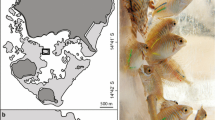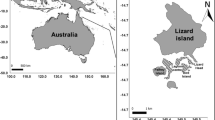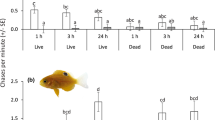Abstract
Triplefin fishes reach their greatest diversity in New Zealand with 26 endemic species, and habitat diversification has been implicated as a key factor in the divergence of this group. Despite this, it is unknown whether species-specific habitat patterns in these sympatric fishes are established by passive processes (e.g. differential mortality) or by habitat selection during settlement. We investigate this question by comparing the habitat associations of new recruits with those of conspecific adults in five species. In addition, the amount of variation in habitat use of conspecific recruits and adults was calculated to identify ontogenetic shifts in habitat association. The results indicated that while there were some differences between recruit and adult habitats, these differences were small in magnitude and habitat use of new recruits was similar to that of adult conspecifics. This finding was further supported by the small difference in variation of habitat use between conspecific recruits and adults. The study suggests that new recruits are actively involved in the selection of habitats at settlement and maintain the use of these throughout demersal life. Habitat use in these territorial species has a large influence on mate choice, thus habitat selection by new recruits would provide a powerful mechanism for pre-zygotic isolation between individuals with different habitat preferences. Together these findings support the notion that habitat diversification has been a major component in the radiation of this sympatric group.






Similar content being viewed by others
References
Almany GR, Webster MS (2006) The predation gauntlet: early post-settlement mortality in reef fishes. Coral Reef 25:19–22. doi:10.1007/s00338-005-0044-y
Bean K, Jones GP, Caley JM (2002) Relationships among distribution, abundance and microhabitat specialisation in a guild of coral reef triggerfish (family Balistidae). Mar Ecol Prog Ser 233:263–272
Berlocher SH, Feder JL (2002) Sympatric speciation in phytophagous insects: moving beyond controversy. Annu Rev Entomol 47:773–815. doi:10.1146/annurev.ento.47.091201.145312
Bierne N, Bonhomme F, David P (2003) Habitat preference and the marine speciation paradox. Proc R Soc Ser B 270:1399–1406. doi:10.1098/rspb.2003.2404
Brix O, Clements KC, Wells RMG (1999) Haemoglobin components and oxygen transport in relation to habitat distribution in triplefin fishes (Tripterygiidae). J Comp Physiol 169:329–334
Bush GL (1969) Sympatric host race formation and speciation in frugivorous flies of the genus Rhagoletis (Diptera, Tephritidae). Evolution 23:237–251
Carr M, Syms C (2006) Recruitment. In: Allen LG, Pondella DJ, Horn MH (eds) The ecology of marine fishes: California and adjacent waters. University of California Press, Berkeley, pp 411–427
Clements KC (2003) Triplefins. In: Andrew N, Francis M (eds) The living reef. The ecology of New Zealand’s rocky reefs. Craig Potton Publishing, Nelson, pp 160–167
Connell SD, Jones GP (1991) The influence of habitat complexity on postrecruitment processes in a temperate reef fish population. J Exp Mar Biol Ecol 151:271–294
Feary DA, Clements KC (2006) Habitat use by triplefin fishes (family Tripterygiidae) on rocky reefs in New Zealand. J Fish Biol 69:1031–1046. doi:10.1111/j.1095-8649.2006.01178.x
Feder JL (1998) The apple maggot fly, Rhagoletis Pomonella: flies in the face of conventional wisdom about speciation. In: Howard D, Berlocher S (eds) Endless forms: species and speciation. Oxford University Press, Oxford, pp 130–144
Francis MP (2001) Coastal fishes of New Zealand. An identification guide. Reed Books, Auckland
Fricke R (1994) Tripterygiid fishes of Australia, New Zealand and the Southwest Pacific Ocean (Teleostei). Koeltz Scientific Books, Königstein
Funk DJ, Filchak KE, Feder JL (2002) Herbivorous insects: model systems for the comparative study of speciation ecology. Genetica 116:251–267
Futuyma DJ, Mayer GC (1980) Non-allopatric speciation in animals. Syst Zool 29:254–271
Gavrilets S (2004) Fitness landscapes and the origin of species. Princeton University Press, Princeton
Hickey AJR, Clements KC (2003) Key metabolic enzymes and muscle structure in triplefin fishes (Tripterygiidae): a phylogenetic comparison. J Comp Physiol B 173:113–123. doi:10.1007/s00360-002-0313-9
Hickey AJR, Clements KC (2005) Genome size evolution in New Zealand triplefin fishes. Heredity 7:356–362. doi:10.1093/jhered/esi061
Hickford MJH, Schiel DR (2003) Comparative dispersal of larvae from demersal versus pelagic spawning fishes. Mar Ecol Prog Ser 252:255–271
Hixon MA, Beets JP (1989) Shelter characteristics and Caribbean fish assemblages: experiments with artificial reefs. Bull Mar Sci 44:666–680
Johnson PA, Hoppensteadt FC, Smith JJ, Bush GL (1996) Conditions for sympatric speciation: a diploid model incorporating habitat fidelity and non-habitat assortative mating. Evol Ecol 10:187–205. doi:10.1007/BF01241784
Jones AG, Kvarnemo C, Walker D, Avise JC (2003) Sympatric speciation as a consequence of male pregnancy in seahorses. Proc Natl Acad Sci USA 100:6598–6603. doi:10.1073/pnas.1131969100
Jones GP (1988) Ecology of rocky reef fish of north-eastern New Zealand: a review. NZ J Mar Freshwater Res 22:445–462
Kauffman L, Ebersole JP, Beets JP, McIvor CC (1992) A key phase in the recruitment dynamics of coral reef fishes: post-settlement transition. Environ Biol Fishes 34:109–118
Keough SJ, Downes BJ (1982) Recruitment of marine invertebrates: the role of active larval choices and early mortality. Oecologia 54:1432–1939. doi:10.1007/BF00380003
Kingsford MJ, Choat HJ (1989) Horizontal distribution patterns of presettlement reef fish: are they influenced by the proximity of reefs? Mar Biol 101:285–297. doi:10.1007/BF00428124
Kirkpatrick M (2000) Reinforcement and divergence under assortative mating. Proc R Soc Ser B 267:1649–1655. doi:10.1098/rspb.2000.1191
La Mesa G, Vacchi M (2005) Analysis of the blennioid assemblages associated with different rocky shore habitats in the Ligurian Sea. J Fish Biol 66:1300–1327. doi:10.1111/j.0022-1112.2005.00684.x
McDermott CJ, Shima JS (2006) Ontogenetic shifts in microhabitat preference of the temperate reef fish Forsterygion lapillum: implications for population limitation. Mar Ecol Prog Ser 320:259–266
McKinnon JS, Mori S, Blackman BK, David L, Kingsely DM, Jamieson L, Chou J, Schluter D (2004) Evidence for ecology’s role in speciation. Nature 429:294–298. doi:10.1038/nature02556
Montgomery JC, Tolimieri N, Haine OS (2001) Active habitat selection by pre-settlement reef fishes. Fish Fisheries 2:261–277. doi:10.1046/j.1467-2960.2001.00053.x
Morris DW (2003) Toward an ecological synthesis: a case for habitat selection. Oecologia 136:1–13. doi:10.1007/s00442-003-1241-4
Munday PL, Herwerden Lv, Dudgeon CL (2004) Evidence for sympatric speciation by host shift in the sea. Curr Biol 14:1498–1504. doi:10.1016/j.cub.2004.08.029
Nagel L, Schluter D (1998) Body size, natural selection, and speciation in sticklebacks. Evolution 52:209–218. doi:10.1126/science.287.5451.306
Nosil P (2007) Divergent host plant adaptation and reproductive isolation between ecotypes of Timema cristinae walking sticks. Am Nat 169:151–163. doi:10.1086/510634
Paulin CD, Roberts CD (1992) The rockpool fishes of New Zealand. Museum of New Zealand, Te Papa
Rice WR, Salt GW (1988) Speciation via disruptive selection on habitat preference: experimental evidence. Am Nat 131:911–917
Schliewen UK, Rassmann M, Markmann J, Markert T, Kocher DT (2001) Genetic and ecological divergence of a monophyletic cichlid species pair under fully sympatric conditions in Lake Ejagham, Cameroon. Mol Biol 10:1471–1488
Schneider KA, Bürger R (2006) Does competitive divergence occur if assortative mating is costly? J Evol Biol 19:570–588. doi:10.1111/j.1420-9101.2005.01001.x
Syms C (1992) Spatial scale and the structure and dynamics of a blennioid fish guild. MSc thesis, Zoology, Auckland
Syms C (1995) Multi-scale analysis of habitat association in a guild of blennioid fishes. Mar Ecol Prog Ser 125:31–43
Syms C, Jones GP (1999) Scale of disturbance and the structure of a temperate fish guild. Ecology 80:921–940
Thomas MLH (1986) A physically derived exposure index for marine shorelines. Ophelia 25:1–13
Thompson S (1983) Homing in a territorial reef fish. Copeia 3:832–834
Thorman S (1986) Physical factors affecting the abundance and species richness of fishes in the shallow waters of the southern Bothnian Sea, Sweden. Estuar Coast Shelf Sci 22:357–370
Tolimieri N, Jeffs A, Montgomery JC (2000) Ambient sound as a cue for navigation by the pelagic fish larvae of reef fishes. Mar Ecol Prog Ser 207:219–224. doi:10.3354/meps207219
Tupper M, Boutilier RG (1997) Effects of habitat settlement, growth, predation risk and survival of a temperate reef fish. Mar Ecol Prog Ser 151:225–236
Wellenreuther M, Barrett PT, Clements KD (2007a) Ecological diversification in habitat use in subtidal triplefin fishes (Tripterygiidae). Mar Ecol Prog Ser 330:235–246
Wellenreuther M, Clements KD (2007) Reproductive isolation in temperate reef fishes. Mar Biol 152:619–630. doi:http://doi.org/10.1007/s00227-007-0713-1
Wellenreuther M, Syms C, Clements KD (2007b) Consistent habitat use across biogeographic gradients. Ecography 30. doi:http://doi.org/10.1111/j.2007.0906-7590.05270.x
Wellenreuther M, Syms C, Clements KD (2008) The role of body size in ecological diversification and reproductive isolation in a sister species pair of triplefin fishes. Evol Ecol. doi:http://doi.org/10.1007/s10682-007-9183-7 (in press)
Acknowledgments
We thank B. Doak and M. Birch for skippering the R. V. “Hawere” and Z. Hilton and D. Moran for field assistance. Statistical analyses were greatly improved by C. Syms. Two anonymous reviewers provided helpful comments on this manuscript. This study was supported by the Marsden Fund of the New Zealand Royal Society (02-UOA-005) to K. Clements. M. Wellenreuther was funded by a Top Achiever Scholarship from the Tertiary Education Commission (TEC) and a doctoral scholarship from the University of Auckland.
Author information
Authors and Affiliations
Corresponding author
Additional information
Communicated by M.I. Taylor.
Rights and permissions
About this article
Cite this article
Wellenreuther, M., Clements, K.D. Determinants of habitat association in a sympatric clade of marine fishes. Mar Biol 154, 393–402 (2008). https://doi.org/10.1007/s00227-008-0940-0
Received:
Accepted:
Published:
Issue Date:
DOI: https://doi.org/10.1007/s00227-008-0940-0




